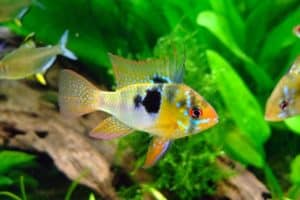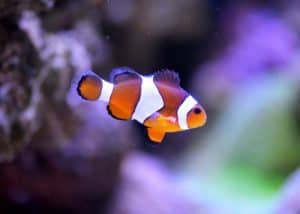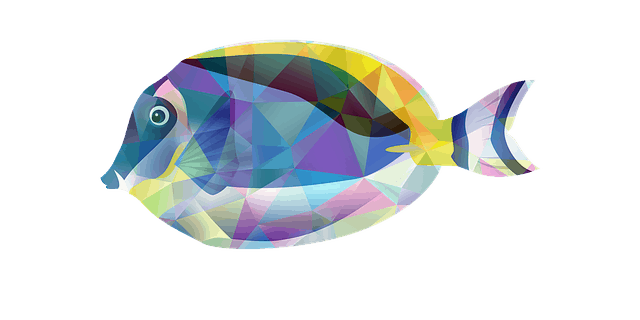Aquarium fish are such a joy to watch. Between the fish swimming around ever so gracefully, to the water bubbles floating softly on the surface, to the live plants swaying in the current, it creates a peaceful, soothing atmosphere wherever you are! What makes it even more enjoyable is watching fish that have beautiful, bright colors which just seem to pop!
If you want to enhance your aquarium’s fish colors, there are both natural and artificial ways to do so. Keeping the fish tank water conditions ideal for your fish will enhance colors naturally. Some fish food can enhance fish colors. Good lighting will help to enhance your fish’s colors as well.
Below we will explore these options so you too can have a vibrant, healthy tank with bright, beautiful fish.
Why Worry About the Color of Fish?
First, why should we really worry about the color of our fish? If anything it is probably mostly because we as humans really enjoy vibrant colors. As an aquarium hobbyist, it is both fun and fascinating learning new ways to improve the aquarium fish color.
That being said, you might just notice one day that some of the inhabitants of your tank just don’t have that special colour and pizazz anymore. So the logical thing to do would be to research ways to improve their pigments.
What Gives Fish its Color?
Chromataphores are what give fish their color. They are a group of cells which reflect light and also contain pigment. There are both natural and artificial ways to enhance these chromataphores which we will investigate below.
Natural ways to enhance aquarium fish color:
- Exceptional water quality – a water conditioner is essential for a healthy tank, and by extension, bright, lively fish. It removes chlorine from tap water and helps neutralize ammonia. An efficient filtration system will also removes nitrite and keep the water clear. Weekly partial water changes is also recommended.
- Healthy social environment – when a fish is under stress, its color will fade. Making sure the social environment is balanced, so no fish is being bullied or threatened by another, is key. Do this by having compatible tank mates, such as school fish. Betta fish, for example, can thrive in an aquarium with Cory catfish and Guppies. Do your research to be sure that the fish in your tank can co-exist in a stress-free environment.
- Premium fish food – using a variety of foods provides your fish with essential vitamins and minerals, keeping them healthy. This directly affects their color and vibrancy. Spirulina, for example, is a type of algae known to naturally enhance pigment in fish. It is bluish-green and can be found in varying types of fish flakes and pellets available online or at your local pet shop. Bloodworms, brine shrimp and krill are other examples of natural color enhancing foods.
Artificial Ways to Enhance Aquarium Fish Color:
- LED lighting – available in a multitude of color spectrums, LED lighting is another way of enhancing fish hue. They create shimmer and glimmer effects in the tank, with the ability to dim one color and brighten another, allowing you to customize the lightening. Want some awesome LED lighting? Make sure to go check out our Recommended lighting page after reading this article.
- Vitamin supplements – adding supplements to your fishes diet can also help improve their coloring. They are available in liquid form and administered by putting drops onto the dry, frozen or live fish food before dropping into the tank. An added benefit of using supplements is an increased resistance to illness and improved immunity among fish.
- Painted Fish – a type of ornate fish which has been artificially colored or ‘juiced’ to appeal to buyers. Juicing is done in one of three ways: injecting fish with dye; dipping fish in a dye solution; or feeding fish dyed food. All of which make the fish appear brighter, however, the effect is not permanent and will fade in six months or so. It is good to note here that the practice is controversial in nature often deemed inhumane by fish enthusiasts.
Fish Color Enhancing Hormones
Is it safe? Another controversial method is using hormones to enhance fish pigmentation. They are usually available in flake form and when fed to fish will brighten them so much as to say they almost glow!
However, once the hormone is no longer administered, the fish will darken in color, never to regain its natural hue again! Possible side effects of this treatment can include infertility, illness and even death! Needless to say, this practice is often frowned upon by aquarium hobbyists and fish lovers alike.
Using the Art of Color to Enhance Fish Pigmentation in an Aquarium
Contrasting colors in an aquarium is a great way to make the tank ‘pop’ with life and vitality. Think of a color wheel, for example. Use it to determine which colors contrast (compliment) one another.
Do this when choosing the gravel, plants and decorations for the tank. For example, purple fish like Tang or Royal Gramma look beautiful swimming around green plants. Bright pink fish like Betta fish or Cichlids will pop when swimming near fluorescent blue gravel.
Rainbow fish look amazing swimming next to black-and-white Convict Cichlids. Contrast helps the fish ‘stand out’ it its environment. Thusly, having contrasting colors within your aquarium will create interest in and draw attention to the tank.
Does Color Enhancing Fish Food Work?
YES! In fact, it is the safest way to naturally enhance fish pigmentation, along with excellent water quality and a healthy, harmonious social environment. As an example here are some examples of some common aquarium fish and what foods work best to help enhance their beautiful colors.
How to Enhance Betta Fish Color?
A variety of foods is essential for healthy Betta Fish color. Spirulina, brine shrimp, salmon and herring are all good examples.
How to Enhance Koi fish Color?
Spirulina, krill and shrimp are great for making Koi fish color pop as well as providing essential nutrients for fish health.
How to Enhance Cichlid Color?
Brine shrimp and bloodworms are best for carnivorous Cichlids whereas greens like lettuce and spinach enhance pigment in herbivorous Cichlid fish.
How to Enhance Discus Fish Color?
Brine shrimp, bloodworms, earthworms and insects like mosquitos are good examples of Discus fish that enhance color. And of course, spirulina is another excellent example of a pigment amplifying nutriment.
There are just so many varieties of fish food available to choose from. One food I recommend you check out is this color enhancing fish food over on Amazon. It will help keep your fish healthy and colorful.
Five Types of Colorful Fresh and Saltwater Fish to Consider
Something you might consider is stocking your tank whether it is a freshwater or saltwater aquarium with some very colorful fish. Here are some options however there are literally hundreds of different types of aquarium fish you can buy. This will depend of what region you are in if you go to a local fish store or if you want to try ordering online that is always an option as well.
Colorful Freshwater fish
- Discus fish – these bright and lively fish come in a variety of colors and color patterns. They are often considered a ‘high maintenance’ fish, as they need exceptionally clean and clear water with a PH level of 5-7 specifically to thrive. They eat live food such as worms and brine shrimp.
- Blue Ram – these highly social and tranquil fish stand out in a tank with their fluorescent blue, orange and yellow markings. They are fairly easy to maintain as they simply require a freshwater tank and some dense foliage or cave-like decorations to ‘hide out’ in occasionally. They eat live and frozen blood worms and brine shrimp.

- Rainbow fish – like the name states, these fish are bright and colorful, just like a rainbow! Their pigment is maintained through diet and a specific water PH level of 7-8. They thrive in a tank with heavy vegetation and a spacious swimming area. They eat spirulina, frozen or live mosquito larvae and bloodworms.
- Electric Blue Cichlid (Hap) – this fish (the male specifically) is stunning to look at with its bright blue scales that almost appear to glow-in-the-dark! They are a schooling fish that live harmoniously with most other species, however, only male per tank is recommended (with three to six female Haps). Like other Cichlids, they eat brine shrimp, bloodworms and spirulina flakes and thrive in an environment of heavy foliage, large rocks and ample swimming area.
- Betta fish – these fish are a consumer favorite due to their vibrant color patterns and floating angel-like fins. While it is often assumed that these fish should be kept in a solitary tank, female Bettas can survive quite well together. It is the male species that are territorial and will ‘fight’ each other. They can, however, be placed individually in a varietal tank. They eat bloodworms, mosquito larvae and brine shrimp. A minimum of one to two gallon tank is recommended with some plant life present for sanctuary.
Colorful Saltwater Fish
- Tangs – these beautiful and resilient fish are a favorite among saltwater aquarium hobbyists. They come in a variety of colors including yellow, purple and blue (think Dory from Finding Nemo)! While they tend to be peaceful in a community tank, they can become aggressive with one another. They require a large tank (one hundred gallons of water or more) and eat algae, krill, Mysis shrimp and brine shrimp.
- Damsel fish – a vibrant red, blue or yellow color defines this saltwater fish. While they can be aggressive in a community tank, they will do well with other species if the tank has plenty of dense foliage to ‘hide’ in when feeling vulnerable. They can thrive in a smaller tank (minimum thirty gallons) and eat Mysis shrimp, fish eggs, plankton and frozen meaty foods.
- Dottyback – a bright purple and yellow pattern is what makes this lovely fish stand out! Similar to the Damselfish in nature, it can be aggressive if feeling threatened but will do well in a tank with plants, caves and plenty of ‘hiding places’. A thirty-gallon is all this fish requires and survives on a diet of Mysis shrimp, brine shrimp, krill and frozen aquarium food.
- Clownfish – one of my personal favorites. These beautiful orange, black and white fish are a true joy to watch, just like Nemo in Finding Nemo! They are active swimmers which can be aggressive to other species. If alone in a tank with larger fish, they will do just fine. They do however thrive in a tank where an anemone is present. Like other saltwater fish, they eat brine shrimp, krill and other frozen fish foods.

- Gobby fish– these are one of the most vivid of the saltwater fish, ranging from bright colors such as red, orange, yellow, green and blue to the more muted shades of white, grey, black and brown. It is a great species for beginner hobbyists because they are fairly easy to maintain.
- They eat readily available aquarium food such as Mysis shrimp, brine shrimp and other frozen meaty foods and are peaceful in nature, surviving well with a variety of other saltwater aquarium fish. However, they can become territorial with resulting aggressive behavior towards others of their kind.
As an important side-note, the overall health and longevity of the fish in an aquarium are directly dependent on the compatibility of the species present. Always research the types of fish you want in your tank to be sure they can not only survive, but thrive together! Healthy, happy fish are naturally more vibrant in color and personality.
In conclusion, there are many ways to enhance the color and vibrancy of both fresh and saltwater fish in an aquarium. Food, water quality and social environment are key elements. These all contribute to the underlying balance in a tank. The healthier the tank, the more bright and beautiful the fish will be within it.
Related Aquariums-at-Home Articles
Are Lego’s Safe for Aquariums?
How to Bring Out Color in Cichlids
Why is My Clownfish Losing its Color?






